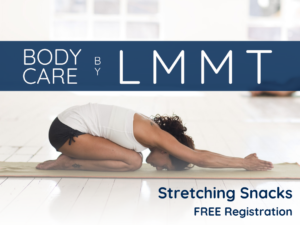We all know that sitting all day can be rough on our bodies, and that we should get up and move around during our work days. But, oftentimes we don’t actually know how to add them into our already packed schedules, or how to make them both efficient and useful. So, we’re here to give you 3 keys to movement breaks.
It is so easy to get lost in a project. Sometimes, we have so many back-to-back things going on, we completely lose track of time. All of a sudden, the whole work day has passed, and we never took a quality movement break. Cue the headaches, shoulder tension, and back pain!
If you don’t have a smartwatch to harass you, you can set a timer or regular alarms on your phone. If your work calendar is the ruler of your daily universe, schedule movement breaks into your workday calendar. Whatever method you choose, notifications will help ensure you actually get up and move. We know you’ll have to miss one occasionally, but we’re willing to bet that if you’re getting “move!” notifications, you’ll get up and move more often than you would otherwise, and in our book, that’s a win!
What in the world is a “stretching snack”? Just like a food snack is a smaller version of a meal, a stretching snack is a bite-sized stretching routine. A stretching snack routine should only take about 2-3 minutes, and should be no more than 5 minutes. To be effective, your routine should be designed to undo your workday activities or postures.
Our favorite stretching snack routine is designed to undo sitting for extended periods. It’s great for desk work, long commutes, and road trips. In our experience, this routine can combat about 1.5 to 2 hours of sitting. The goal is to undo the physical demands of desk and computer time quickly so you can get back to work.

Getting up to go to the bathroom or get coffee doesn’t count. Neither does walking around on your phone. Sorry! You need 5-15min for this one. In order to make the most of your walk, it’s helpful to understand why a walk helps.
First, muscles will become overly short or overly long after sitting all day. Standing and walking helps change that muscle length. Second, our sitting posture tends to fatigue during the day, which results in a collapsed torso, restricting how well we can use our diaphragm. So, standing and walking also give us the opportunity to breathe better. That’s not all though! The movement of walking, specifically, causes small spinal rotations which help to loosen up and increase blood flow to all those little muscles around your spine.
There’s a catch. This only works if you actually let your spine rotate. Many of us hold our spine stiff while we walk either because we are carrying something or looking at our phones. Some people hold stiff spinal postures for other reasons such as a dog pulling on a leash or a history of dance/acrobatic activity. Whatever the reason is, we need to let those spines rotate now!
Don’t worry- we’ve got some helpful tips for reconnecting with spinal rotation during gait. Before you walk, stand up and rotate your torso back and forth, allowing your arms and hands to be loose and swing around. You’re not actively trying to swing your arms, but their movement is great feedback! The more you can relax the muscles around your spine, the more your arms will swing around your body. While you’re walking, keep your hands free of phones, dog leashes, or anything else. This is a time for you and your body to get some blood flow to critical areas and enjoy a short break.
Bonus! The bilateral (balanced right and left side) movement of walking will also help clear brain fog and get you back focused again.
It’s not always easy to add self-care into your day. Having a goal creates a why, and having a strategy creates a how. Together, these help us maintain our commitment to movement breaks. We can have confidence we’re being both efficient and effective. We’re achieving goals and then getting back to work.